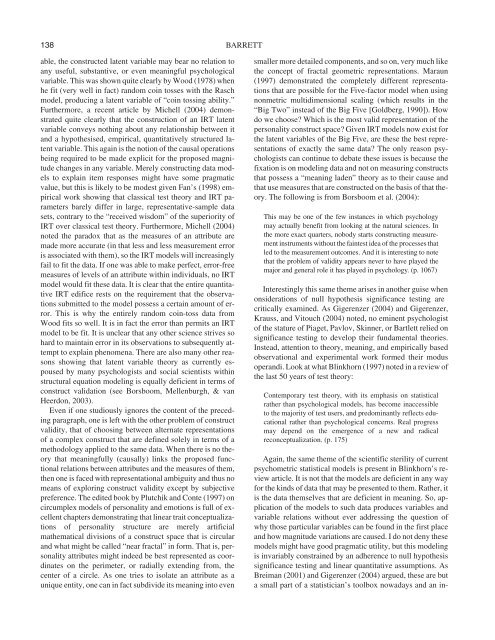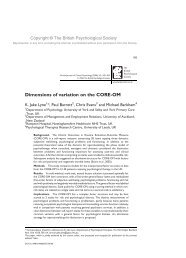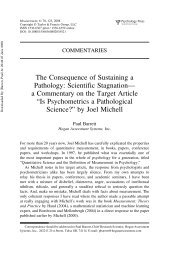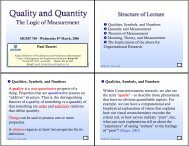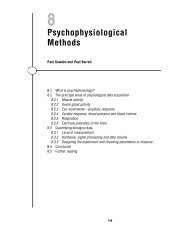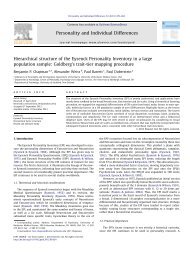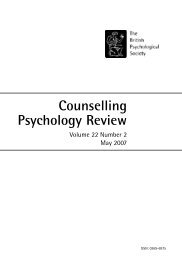What If There Were No Psychometrics?: Constructs ... - Paul Barrett
What If There Were No Psychometrics?: Constructs ... - Paul Barrett
What If There Were No Psychometrics?: Constructs ... - Paul Barrett
You also want an ePaper? Increase the reach of your titles
YUMPU automatically turns print PDFs into web optimized ePapers that Google loves.
138 BARRETT<br />
able, the constructed latent variable may bear no relation to<br />
any useful, substantive, or even meaningful psychological<br />
variable. This was shown quite clearly by Wood (1978) when<br />
he fit (very well in fact) random coin tosses with the Rasch<br />
model, producing a latent variable of “coin tossing ability.”<br />
Furthermore, a recent article by Michell (2004) demonstrated<br />
quite clearly that the construction of an IRT latent<br />
variable conveys nothing about any relationship between it<br />
and a hypothesised, empirical, quantitatively structured latent<br />
variable. This again is the notion of the causal operations<br />
being required to be made explicit for the proposed magnitude<br />
changes in any variable. Merely constructing data models<br />
to explain item responses might have some pragmatic<br />
value, but this is likely to be modest given Fan’s (1998) empirical<br />
work showing that classical test theory and IRT parameters<br />
barely differ in large, representative-sample data<br />
sets, contrary to the “received wisdom” of the superiority of<br />
IRT over classical test theory. Furthermore, Michell (2004)<br />
noted the paradox that as the measures of an attribute are<br />
made more accurate (in that less and less measurement error<br />
is associated with them), so the IRT models will increasingly<br />
fail to fit the data. <strong>If</strong> one was able to make perfect, error-free<br />
measures of levels of an attribute within individuals, no IRT<br />
model would fit these data. It is clear that the entire quantitative<br />
IRT edifice rests on the requirement that the observations<br />
submitted to the model possess a certain amount of error.<br />
This is why the entirely random coin-toss data from<br />
Wood fits so well. It is in fact the error than permits an IRT<br />
model to be fit. It is unclear that any other science strives so<br />
hard to maintain error in its observations to subsequently attempt<br />
to explain phenomena. <strong>There</strong> are also many other reasons<br />
showing that latent variable theory as currently espoused<br />
by many psychologists and social scientists within<br />
structural equation modeling is equally deficient in terms of<br />
construct validation (see Borsboom, Mellenburgh, & van<br />
Heerdon, 2003).<br />
Even if one studiously ignores the content of the preceding<br />
paragraph, one is left with the other problem of construct<br />
validity, that of choosing between alternate representations<br />
of a complex construct that are defined solely in terms of a<br />
methodology applied to the same data. When there is no theory<br />
that meaningfully (causally) links the proposed functional<br />
relations between attributes and the measures of them,<br />
then one is faced with representational ambiguity and thus no<br />
means of exploring construct validity except by subjective<br />
preference. The edited book by Plutchik and Conte (1997) on<br />
circumplex models of personality and emotions is full of excellent<br />
chapters demonstrating that linear trait conceptualizations<br />
of personality structure are merely artificial<br />
mathematical divisions of a construct space that is circular<br />
and what might be called “near fractal” in form. That is, personality<br />
attributes might indeed be best represented as coordinates<br />
on the perimeter, or radially extending from, the<br />
center of a circle. As one tries to isolate an attribute as a<br />
unique entity, one can in fact subdivide its meaning into even<br />
smaller more detailed components, and so on, very much like<br />
the concept of fractal geometric representations. Maraun<br />
(1997) demonstrated the completely different representations<br />
that are possible for the Five-factor model when using<br />
nonmetric multidimensional scaling (which results in the<br />
“Big Two” instead of the Big Five [Goldberg, 1990]). How<br />
do we choose? Which is the most valid representation of the<br />
personality construct space? Given IRT models now exist for<br />
the latent variables of the Big Five, are these the best representations<br />
of exactly the same data? The only reason psychologists<br />
can continue to debate these issues is because the<br />
fixation is on modeling data and not on measuring constructs<br />
that possess a “meaning laden” theory as to their cause and<br />
that use measures that are constructed on the basis of that theory.<br />
The following is from Borsboom et al. (2004):<br />
This may be one of the few instances in which psychology<br />
may actually benefit from looking at the natural sciences. In<br />
the more exact quarters, nobody starts constructing measurement<br />
instruments without the faintest idea of the processes that<br />
led to the measurement outcomes. And it is interesting to note<br />
that the problem of validity appears never to have played the<br />
major and general role it has played in psychology. (p. 1067)<br />
Interestingly this same theme arises in another guise when<br />
onsiderations of null hypothesis significance testing are<br />
critically examined. As Gigerenzer (2004) and Gigerenzer,<br />
Krauss, and Vitouch (2004) noted, no eminent psychologist<br />
of the stature of Piaget, Pavlov, Skinner, or Bartlett relied on<br />
significance testing to develop their fundamental theories.<br />
Instead, attention to theory, meaning, and empirically based<br />
observational and experimental work formed their modus<br />
operandi. Look at what Blinkhorn (1997) noted in a review of<br />
the last 50 years of test theory:<br />
Contemporary test theory, with its emphasis on statistical<br />
rather than psychological models, has become inaccessible<br />
to the majority of test users, and predominantly reflects educational<br />
rather than psychological concerns. Real progress<br />
may depend on the emergence of a new and radical<br />
reconceptualization. (p. 175)<br />
Again, the same theme of the scientific sterility of current<br />
psychometric statistical models is present in Blinkhorn’s review<br />
article. It is not that the models are deficient in any way<br />
for the kinds of data that may be presented to them. Rather, it<br />
is the data themselves that are deficient in meaning. So, application<br />
of the models to such data produces variables and<br />
variable relations without ever addressing the question of<br />
why those particular variables can be found in the first place<br />
and how magnitude variations are caused. I do not deny these<br />
models might have good pragmatic utility, but this modeling<br />
is invariably constrained by an adherence to null hypothesis<br />
significance testing and linear quantitative assumptions. As<br />
Breiman (2001) and Gigerenzer (2004) argued, these are but<br />
a small part of a statistician’s toolbox nowadays and an in-


